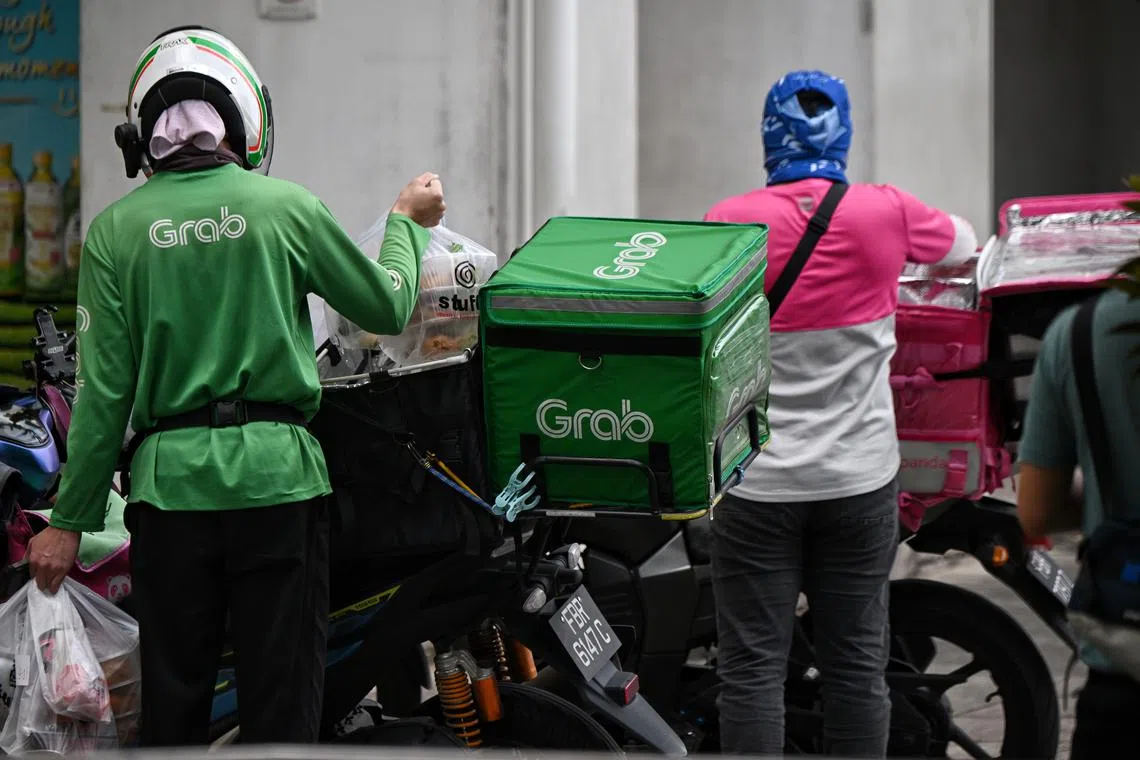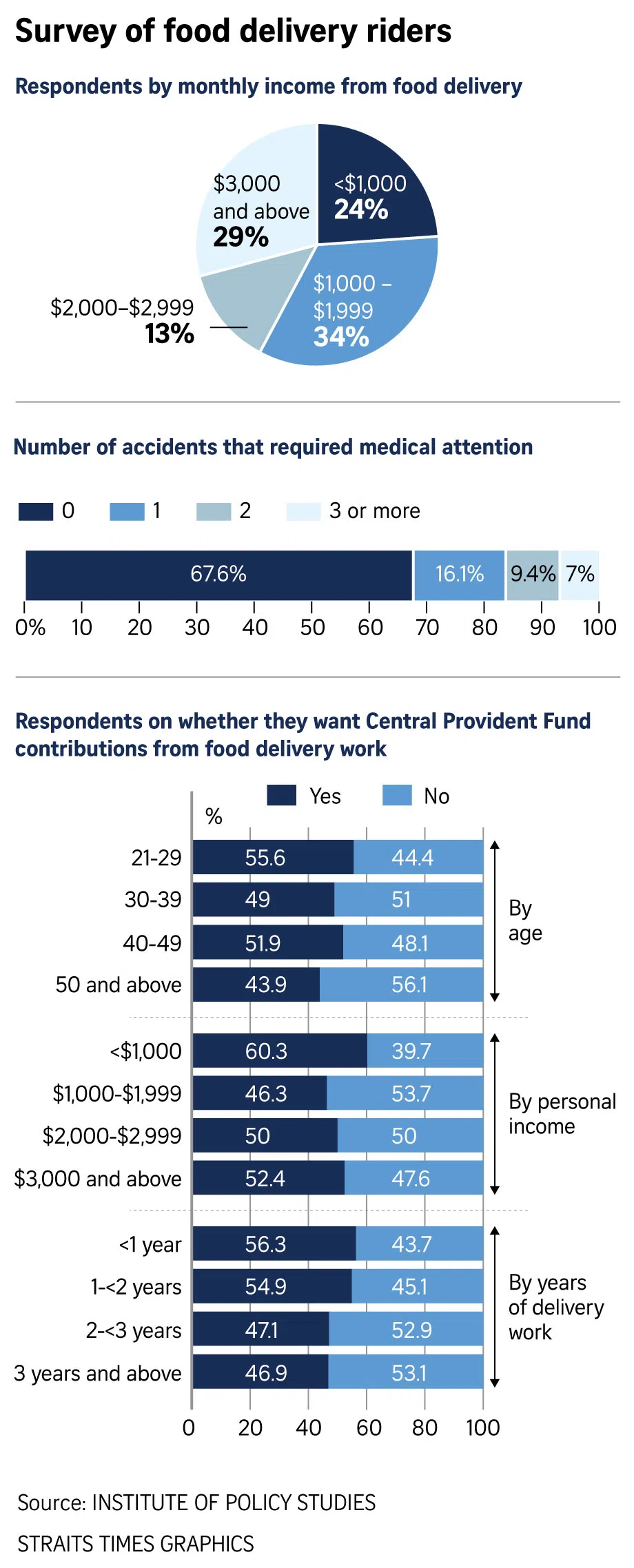Modest pay, long hours: IPS survey highlights vulnerability of food delivery workers in S’pore
Sign up now: Get ST's newsletters delivered to your inbox

About 46 per cent of respondents said they relied solely on food delivery for their personal income.
PHOTO: ST FILE
Follow topic:
SINGAPORE - Seven out of 10 food delivery riders here reported earning a monthly income of less than $3,000 from delivery work, with a median monthly income of $1,925 – less than half the national median monthly salary of $4,680 in 2021.
Yet roughly four in 10 said they work more than 44 hours a week – the maximum recommended under the Employment Act – while just one in four felt they had enough savings to support themselves and their families in the short term if they stopped working.
These findings from a survey of 1,002 food delivery workers, which also found that about one-third of them had been in an accident, show a clear need for broad-based social protections for this vulnerable group, including mandatory Central Provident Fund (CPF) contributions, said researchers from the Institute of Policy Studies (IPS) in a paper published on Friday.
This is despite the fact that seven in 10 food delivery workers polled preferred to earn more cash than to receive these additional protections, with a roughly even split between those who wanted CPF contributions and those who did not.
The researchers, led by IPS Social Lab head, Dr Mathew Mathews, said only those who earned at least a quarter of their monthly income from food delivery took part in the survey, which was conducted in July and August.
About 46 per cent of respondents said they relied solely on food delivery for their personal income.
The poll follows an earlier study conducted by IPS a survey of 4,200 food delivery workers published in March
But in their latest report, the IPS researchers said some delivery workers have pointed out that the high median hourly earnings reported are not accurate, given that they may reflect only peak-hour incomes. Part-timers who often do deliveries during peak hours can earn substantially more fares, they added.
The average food delivery worker did not experience significant changes to their total monthly income after transitioning to delivery work, the IPS report found.
About six in 10 had either no change to their income bracket or saw their total monthly income fall after becoming a food delivery worker.
Only 3.2 per cent were able to earn more than $5,000 a month from food delivery alone, and this took substantial effort and risk, said the researchers.
The report highlighted a 36-year-old worker who earned about $8,000 a month delivering food on a bicycle. He had to work daily from 11am to 9pm, even during thunderstorms and heavy downpours.
About seven in 10 delivery workers polled were worried about not being able to earn enough because the number of workers joining the industry has been outpacing demand.
The researchers said: “This increase in competitiveness, coupled with the decrease in incentives provided by food delivery platforms, has also led to riders having concerns about earning enough from food delivery work to cover the increasing cost of living.”
The IPS poll also found a wide variation in income and working hours, which was attributed to uncertainty in waiting times and the allocation of jobs.
To illustrate this, IPS research associate Thian Wen Li recounted her observations while following two food delivery workers in the Central Business District for a two-hour period. One, who rode a motorcycle, earned $20 in that time, while the other, who walked, earned $70.
While about half of the food delivery workers polled said they work less than 39 hours a week, close to half said they have taken less than a week’s break from food delivery work since they first started.
The researchers said: “While there are possibilities for high earnings through platform work... few achieve such success.
“Those who do, sometimes put themselves in much risk, as seen in the higher number of accidents and risky behaviour of those who earn more.
“Moreover, the generally lower incomes of the bulk of riders are not based on their lack of effort.”

The fear of not being able to earn enough from food delivery was also the main reason why 48.8 per cent of the workers polled did not want to make CPF contributions, or force delivery firms to do so.
About six in 10 said they were worried that if delivery platform companies have to pay into their CPF accounts, the firms would find ways to take this from their earnings.
The researchers said their interviews with delivery workers found that some preferred more nuanced implementations of CPF into platform work, and it should not be one-size-fits-all.
More transparency may be needed to make sure that platform companies do not fund CPF contributions using what should be due to workers, they added.
The researchers also noted that the split over mandatory CPF showed a tussle between wages and better protection.
“While immediate needs are paramount, longer-term considerations cannot be avoided and have to be attended to adequately... the ideal will be to ensure both adequate protections, and a decent wage,” they said.
“At some point, all workers have to accept that there is a need to sacrifice some income earned currently for the sake of long terms goals, especially if these savings when matched with employer contributions can go some way to servicing even much needed near-term housing goals.”
The IPS poll also found that six in 10 delivery riders were satisfied with their income and said they earned enough to cover their and their family’s basic living expenses.
About six in 10 believed that the gig economy is the future of work, and about half foresee themselves staying in food delivery work for at least another three to five years, with this proportion increasing the longer workers have been in the sector.
But about two in five said they would leave the food delivery industry as soon as possible if they had job opportunities in other industries. Even so, only one in five said they have taken up training opportunities that would enable them to do so, the researchers noted.
These figures should be a cause for concern as it points to entrenchment in platform work, they added.
Said Dr Mathews at a media briefing on Friday: “We are particularly concerned with young people who are part of this... Whether this is best way of using their human capital, their training, their education.”
The researchers said more thought should go into redesigning lower income jobs, so they not only offer decent wages, but also attractive conditions and opportunities for learning and advancement.
“The substantial number of younger, lesser educated platform workers should signal to employers that the workplaces may need to be re-tweaked to better cater to this group,” they added.


